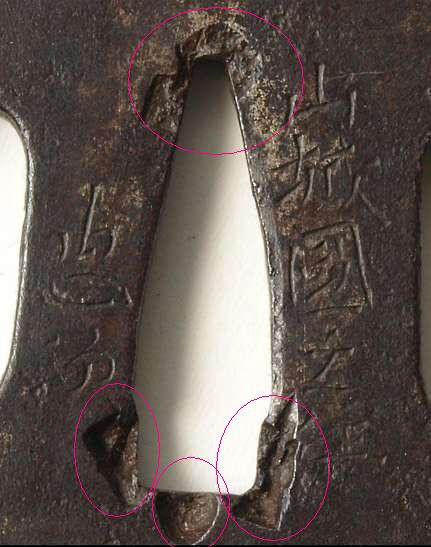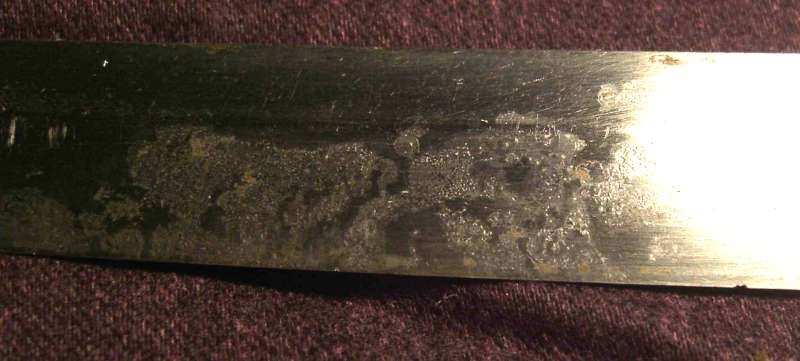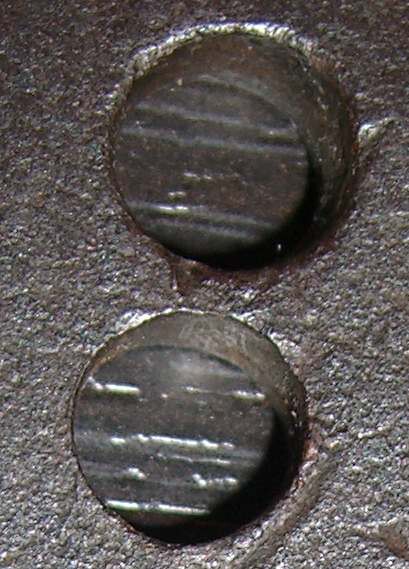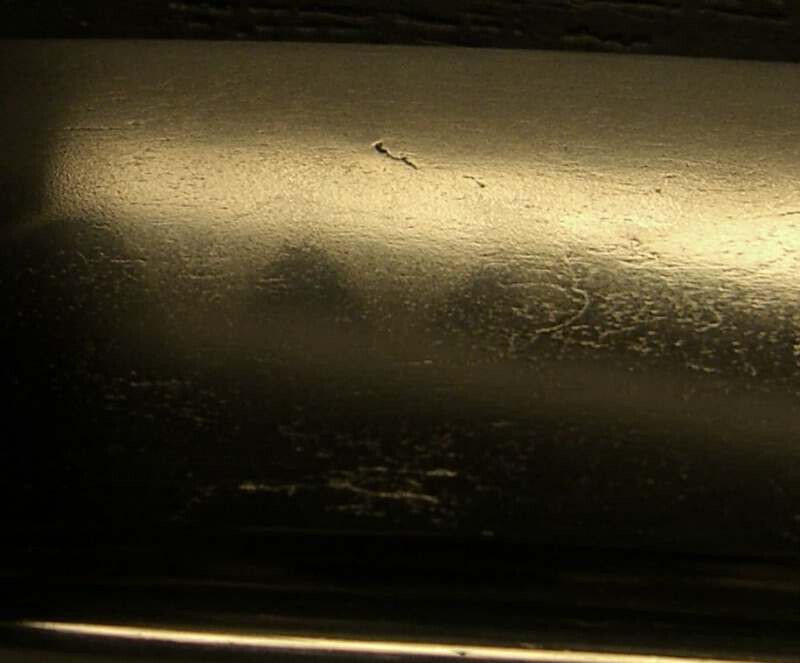-
Posts
81 -
Joined
-
Last visited
Everything posted by Tavroch
-
Questions answered; thanks Brian.
-
I have a question about tsuba that's been haunting me for some time. What are the dents near the centre hole called, and what are they for? At a guess I'd say they are made to try to fit the tsuba to the blade; is this correct? Sometimes they are filled in with copper(?) for the same reason? As I'm at it: can someone point me to a site that has a diagram with names of the tsuba parts?
-
@Peter & Brian: You're right, sorry, false alarm. Turns out to be an absorption pattern in the oil film. The more corroded parts absorbed the oil and the less corroded parts didn't (yet). And this of course corresponds to the peaks and valleys of the hamon, but at a distance, like I understand utsuri does. And that's why I didn't notice it in the previous photo-session with no oil on. Guess this also means I'll have to keep cleaning and oiling it for a while as it is still absorbing the oil. It was bone-dry when I got it. I'll keep oiling and cleaning it until the cloth stays white. This is the way to go in order to stabilise the corrosion isn't it? @Ian: Thanks for the research.
-
As I walked past it this morning I noticed this: The visibility of these is enhanced by the corrosion. That is: the peaks that reach towards the ha are less corroded, more shiny, then the rest of the shinogi. These shiny peaks more or less correspond to the valleys in the hamon. Is this what they call Utsuri?
-
@John: Too bad you couldn't pin down the mon. Anyone else? I was thinking about finding an appropriate saya and having the gunto mounts restored. Then having it polished just enough to polish out most of the rust and pitting, leaving the nicks as they are; this to preserve as much of the healthy shinogi shape as possible and to bring out the hamon. Btw: can this be called a Gunome-Choji hamon? I think I would like a sashikomi polish, like the one it is/was in now, as I don't think I will ever want to have it papered anyway (I understand a hadori polish is kind of mandatory for this). I think WWII is part of its history now, isn't it? A shirasaya and a tsunagi and presto. But you do have a point with your suggestion to sell the gunto mounts to fund the restoration, although it wouldn't get you anywhere close to covering the costs of a restoration I suppose. What kind of mounts would you suggest as appropriate for this kind of blade? @Grey: @Mark: Komaru Boshi; thanks. @Steve: Umegane; that's the word, thanks. That is: if that's what it is. But I think there isn't a polisher out there that lets me tell him what to be careful about, is there? I wouldn't mind if it was: just nice to have a blade with a lot of interesting features. Would be something else if it had cost me an arm and a leg though. As a matter of fact: how serious would a flaw like this be?
-
That leaves us with the saya: Am I correct in assuming it is not original at all? Maybe only the tachi ring-mount is. Is this detachable? And should this be numbered as the rest of the metal fittings? There is a label with some writing on the saya. Readable? From a post-war storage depot? There’s a chunk missing from the saya: Is it possible that this was done to be able to see at a glance that there’s a blade in it? To be complete here’s the bottom end of the saya: I suppose there’s no value in the brass fittings on the saya? If I’d want to restore the gunto fittings, would it be possible to find a replacement period saya to go with the original fittings? That’s it for now. I’d really like to read your opinions/suggestions. If anything is unclear I can try taking more/better pictures. @ John & John: Thanks for your lightspeed reactions. I'm sorry I can't go into them now; I'm already late for my downtime. Please do enjoy the rest of the pictures and do continue commenting on them. I'll have some time later this week, maybe even tomorrow.
-
Can something be said about the tsuba? It’s an open work tsuba; does that tell us anything? Is it early/rare? Here’s the tsuka: On the other side the menuki has been removed by cutting the ito, so this is loose, held together by clear tape now. The top of the tsuka, where the fuchi goes, has some writing: Does this have any significance, or is it possible to tell what is says? Top right there’s a crack. The tsuka looks restorable to me, the same is not in too bad a condition and the ito needs rewrapping of course. There is no mekugi and I had some trouble removing the tsuka, so it’s a very tight fit. Someone before me apparently had the same kind of trouble, but solved it in a less subtle way: the habaki features some dents as a result: I guess it’s a silver plated copper one. It cannot be removed; it doesn’t get past the first mekugi-ana, I think because of the build up of rust there. On the kashira there’s a Myoga mon: Can this be pinned down to a specific family? Does it tell us anything else? For example: is this a family blade adapted for WWII? To be continued...
-
In the kissaki area the hamon is only just visible in the right light: In the last picture I think you can see the turn back of the boshi. I understand the different types of boshi have names too; is it possible to tell which type this is? A very faint line on one side is all that is left of the yokote (not visible in the pix). In the monouchi area the shape of the hamon is only visible in the shape of the rust and pitting: I think someone tried to clean the blade here, which resulted in this rust and pitting. So apparently the hamon area rusts more easily/differently than the non-hardened parts of the blade. I guess this is not surprising. (This is an enhanced picture btw; it looks more serious than it is in reality; it is very shallow, hardly noticable when you run a nail along it. Fingernail that is ; )) On to the mountings. As I said earlier, there is a complete set of seppa (4 on each side of the tsuba): Someone has already tried cleaning them by sanding. Is it ok to clean them any further? If so; what would be the best way to do this? Should I try to polish out the marks left by the sanding? Or are they best left as they are now? As you can see they are all numbered (198), and so are the fuchi and the tsuba. I presume the kashira is numbered accordingly, but there is no way to tell since it is attached to the tsuka by the ito. Does this number have any meaning or significance? To be continued...
-
Speaking of hada: can this be a pocket of air in the steel that has been repaired? If so; it is not done too badly for it is hard to capture. Or is it just loose hada? Impossible to tell by pictures I guess: Here’s some more pix of the hamon, as far as I was able to capture it: Is this kind of hamon called Gunome-Choji? It may not be very clear from these pictures, but the ji has a definite convex shape (niku?), especially near the ha. Can I take this as a sign that the blade is quite healthy? To be continued...
-
Hello all, As some of you might remember, I’ve been looking for an affordable blade made from Namban-tetsu. Thanks to Stephen I recently found one. It’s the one that was discussed here: http://www.militaria.co.za/nmb/viewtopic.php?f=1&t=4605&hilit=kuniyoshi I’d like to discuss it some more in this post, to check what I think I already know about it, to find out all I can about it and to find out what I can do to preserve/restore it. So please tell me what you think and correct me where you think I am wrong. Let me start by posting some pictures: First off, an overall picture; it shows what was shipped to me: As you can see, the saya is not original, the set of seppa is complete, the tsuka-ito is damaged and the blade was shortened (in a rather crude way, as I will show in more detail later). Some dimensions: Overall blade: 89cm, Nagasa: 67cm, Sori: 1cm, Width: 3cm near the hamachi, tapering to 2cm near the kissaki, Kasane: 0.65cm Then of course the mei is of interest: As I am told, it reads “Bungo no Kami Fujiwara Kuniyoshi” and “Motte Namban-tetsu tsukuru koro”. So apparently it was made by Hawley’s KUN 1875 from Settsu province, who was active in 1673, using Namban-tetsu. Another picture of the nakago: The yasurime (filemarks) are just visible here and also the discoloration from the shortening. Also there are these stripes made by the polisher, which I’ve seen on some other blades. Can someone tell me more about those? Is it possible to identify the polisher or the age of the polish by them? Another pic of the crude reshaping that was done, I presume to adapt the blade to the gunto mounts: This is one of the few areas in which the hada can be seen, I think because this area is covered by the habaki, and subsequently the only area that was spared from the buffing that hides most of the hada on the rest of the blade. Please comment on the discoloration: I presume it is fatal? Or isn’t it, since it is covered by the habaki? From what is still visible of the hamon in this area, it looks like it ended in suguha near the hamachi originally, or is this the result of the crude reshaping? To be continued...
-
I like the for sale one best.
-
I mailed them, here's how it went: RvH: Can you please send me your ordering information in English? Including your international shipping and return policies. I live in The Netherlands. Samurai Shokai: Everything is written in Order Form. RvH: I still have a question about point (6) of your order form: “(6)When the tip of delivering is the foreign country, the returns and repayment is not possible,Please approve it.” (Sounds exactly the same as the order-form of e-sword.jp. RvH) Does this mean that your guarantees in point (1) do not apply to foreign customers? In other words: Can I get a full refund if the garantees from point (1) apply? In other words: Can I return a sword and get a full refund if something is wrong with the sword? I want to be absolutely certain of this before I would consider ordering from your shop. Samurai Shokai: >Can I return a sword and get a full refund if something is wrong with the sword? It is not possible to do. RvH: Thank you for your answer. In that case I will not order from your shop. Too bad; you have some nice items. But I will not consider ordering when it is not possible to return goods under guarantee. Thank you for your time. And that's all as far as I'm concerned. Just so you know.
-
Hello all. Can I put in my two cents? @Jean: Every katana on Aoi-Art is in the wakizashi section if you look at the details page. You're right about the rest of course. @Brian: I have been looking at the one you pointed to before, and I noticed the yokote seems very vague, not sharp at all. Especially near the ha. Or does it merely look vague? If a crisp yokote is a sign of a good polish, isn't a vague one a sign of a not so good polish? Furthermore: the koshirae are nice, but the saya is rather badly chipped at the koiguchi. Speaking of yokote: there's something about the katana Mark is/was considering, I've noticed in others before: the yokote on one side seems to have quite a different angle than the one on the other side. Sometimes this is due to the way the two sides are aligned, but this is not the case here I think. Does this too tell us something about the quality of the polish, and thus the overall value of the blade?
-
Hello all, Does anybody have any experience with the "Samurai Shokai" Japanese Sword Online Webshop? Looks like they stock some nice items.
-
And again: http://www.aoi-art.com/sword/katana/07600.html I wish I were rich...
-
@Guido Schiller: Yes, of course, sorry; I was staring at the Mei on the Nakago trying to decipher the engravings. @Grey Doffin: I know, and that's just the problem: every question I ask is ignored. Except when I ask if I can buy this katana, the answer is:"I ask for an official order from here: http://www.e-sword.jp/orderform.htm" That's why I hoped the members of the NMB would be able to provide me with some more info on it. But even then I wouldn't make another move before the seller answers my questions. I hoped that maybe with some more info about it, I would be able to decide if it'd be worth it to insist. By the way: I wouldn't mind you commenting on the asking price, except I beleive it is "not done". I'm no expert and still very much trying to get a feel for relative values. That's also why I asked for opinions on Noriyasu, the shape and the koshirae and fittings.
-
Another Katana made from Dutch steel came up for sale: http://www.aoi-art.com/sword/katana/08374.html That is to say: it went on hold the moment it appeared on the site. Does anyone on this forum happen to know who the holdee is? If this potential owner is from the Netherlands I wouldn't mind if someone could bring me into contact with him. I'd really like the chance to have a look at this blade.
-
Can anyone please comment on this Noriyasu Katana? http://www.e-sword.jp/sale/0810_1116syousai.htm I tried asking the seller about it, but all I get is: "I ask for an official order from here: http://www.e-sword.jp/orderform.htm" Can anything phrased in this kind of messed-up English be of any legal value? And then a line like this: "(6)When the tip of delivering is the foreign country, the returns and repayment is not possible,Please approve it." I asked him if this means you cannot return the blade when you're a foreign customer, so this in fact nullifies point 1: "When the sword which is an imitation of an author or the copy, you receive with selling price." No reaction. I asked him for the original text in Japanese; to have something that's a bit more likely to be legally binding. Again: no reaction. I think it's a nice looking sword though; I noticed the shape: U no Kubi Zukuri if I'm correct? You don't see that everyday. Can anyone comment on the Koshirae and fittings? Would they be a recent addition? Furthermore: this smith Noriyasu: I can't seem to find a lot of info about him. Can anyone here tell me anything about him? I can't see if the Mei looks like 法安 or 則安. Am I correct in assuming there's less chance that a Mei of a smith like this is a fake, because there's only a few smiths that go by that name? If you'd be faking a Mei, it would be safer to pick a name that is used by a lot of smiths, right?
-
I'm still curious: where is the measure traditionally taken when a kasane is given?
-
Kasane measured just above mekugi-ana: 6.4mm, measured about 6cm. above hamachi: 5.2mm. I think that indeed qualifies it as being a bit tired. By the way: where is the measure traditionally taken when a kasane is given? Tsuruta-san admits it is machi-okuri now, and on this page that I found it says "nakago: suriage, 2 mekugi-ana (one filled), okuri-machi". So the Kanemoto is on its way back to Japan now (Tsuruta-san offered to take it back), main reason being that if I knew about it what I know now, I wouldn't have bought it in the first place. I have no problems apologizing to you now, Jacques, although I never said you were wrong in your suspicions. Don't get me wrong: I still think it's a lovely blade, but with al these issues surrounding it, it's not the right one for being my first Nihonto. I don't mind, because this has been a great learning opportunity for me. This leaves me free to keep my eyes open for my real first Nihonto. I thank you all for your input on this.
-
I do appreciate your frankness Jacques. Can I asked you to comment on the flaws you see and explain about their seriousness? I think minor flaws and discussions like the one about it being ubu or not only add to the value it represents to me. After all, this is a study project for me. You think it is tired, for example: what makes you think that? The hira-niku (?) is still fairly rounded, as you can see in some of the foto's; isn't that an indication that it is not very tired yet? And don't you think it's kind of intriguing that there seem to be two descriptions, apparently both from Aoi-Art, that contradict eachother on the ubu or not question? The outcome of this would have an impact value-wise of course, I'm aware of that. I admit that the hadori polish is not very good; it is kind of vague on one side, for example. I think a sashikomi polish would do more justice to this kind of hamon. On the other hand: the hadori polish it's in does give it the kind of subtle flamboyancy I fell for initially, and I don't know how old this polish is. Does anybody have any ideas on this? Besides all that, I'm still very much in love with the overall shape (sugata?). You obviously are not at all bothered by these kinds of feelings. What kind of sword do you like Jacques?
-
Yeah, well, I don't know about them eyeglasses. What I'm really curious about is this: has this Kanemoto been on Aoi-Art before? And if so; why was it described as being suriage then? I put the question to Tsuruta-san just now. Let's await his answer before jumping to conclusions please. The arguments presented in the Dutch Iron post still stand i.m.o. Do you see new evidence to support your opinion on it being suriage apart from the remarks on the quoted page, Jacques? In the new pictures posted by me here for example? By the way: what do you think about the blade as such? Apart from it being ubu or not.
-
A worrying quote from http://www.users.on.net/~coxm/oshigata%20sword%20k35.html: nakago: suriage, 2 mekugi-ana (one filled), okuri-machi It being suriage or machi-okuri was discussed here: http://www.militaria.co.za/nmb/viewtopic.php?f=1&t=3269&st=0&sk=t&sd=a And both mekugi-ana are open on my Kanemoto. If the top one was once filled, the filling has been removed without a trace. The patina looks about the same in both holes: I don't know what to think. Maybe I should indeed bring this to Tsuruta-san's attention.
-
A picture of the Mei: This is the original description on Aoi-Art: Wakizashi in Shirasaya Signature: Kanemoto (NBTHK Hozon Paper) The blade was polished . Blade length : 35.8 cm or 14.09 inches. Sori : 1.1 cm or 0.43 inches. Mekugi: 2 Width at the hamachi : 3.2 cm or 1.25 inches. Kasane : 0.6 cm or 0.23 inches. Era : Late Muromachi period. Shape : The blade is rather wide and thin sakizori style. Jitetsu :Itame hada well grained with Jinie attach. Hamon : Niedeki Sanbonsugi style. Special feature : Early stage of the Kanemoto started Meio era and his son Magoroku Kanemoto is very famous sword smith. There are several generations ,so it is difficult to distinguisg which generation this sword is. But Kanemoto is well known sword smiths for cut well sword. This sword is pretty healthy and recommend. I was surprised to find this: http://www.users.on.net/~coxm/oshigata%20sword%20k35.html Looks like my blade. Here's the two Oshigata for comparison: Looks like exactly the same blade to me. Can it be that this Kanemoto was on Aoi-Art before? What to think of this? Questions arise: sandai or not? What was the price it went for then? Has anybody seen/bought/sold it before? Maybe I should ask Tsuruta-san about this. When it arrived it was completely dry; I mean: there was not a trace of oil on the blade as far as I could tell. I wiped it with uchiko once and the cloth turned a bit brownish. Only a slight bit, mind you, but still. It's oiled now of course. The fact remains that I like the blade regardless. But I would be very intersested in anything any of you'd have to say about this Kanemoto. Additional pictures can be posted on request.
-
Here's some pictures of features that I'm worried about. Which ones are considered flaws, and how serious are they? Some scratches, only visible in the right light: This looks like a tiny pocket of air (Fukure?): Is this called Ware?: To be continued...







































